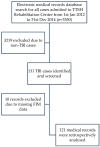Characteristics and Functional Impact of Unplanned Acute Care Unit Readmissions during Inpatient Traumatic Brain Injury Rehabilitation: A Retrospective Cohort Study
- PMID: 37629577
- PMCID: PMC10455652
- DOI: 10.3390/life13081720
Characteristics and Functional Impact of Unplanned Acute Care Unit Readmissions during Inpatient Traumatic Brain Injury Rehabilitation: A Retrospective Cohort Study
Abstract
Background: This study investigated the incidence, characteristics and functional outcomes associated with unplanned Acute Care Unit Readmissions (ACUR) during inpatient traumatic brain injury (TBI) rehabilitation in an Asian cohort.
Methods: A retrospective review of electronic medical records from a single rehabilitation unit was conducted from 1 January 2012 to 31 December 2014. Inclusion criteria were first TBI, aged >18 years, admitted <6 months of TBI. ACUR were characterized into neurological, medical or neurosurgical subtypes. The main outcome measure was discharge and Functional Independence Measure (FIM™). Secondary outcomes included rehabilitation length of stay (RLOS).
Results: Of 121 eligible TBI records, the incidence of ACUR was 14% (n = 17), comprising neurologic (76.5%) and medical (23.5%) subtypes occurring at median of 13 days (IQR 6, 28.5) after rehabilitation admission. Patients without ACUR had a significantly higher admission mean (SD) FIM score compared to those with ACUR (FIM ACUR-negative 63.4 (21.1) vs. FIM ACUR-positive 50.53(25.4), p = 0.026). Significantly lower discharge FIM was noted in those with ACUR compared to those without. (FIM ACUR-positive 65.8(31.4) vs. FIM ACUR-negative 85.4 (21.1), p = 0.023) Furthermore, a significant near-doubling of RLOS was noted in ACUR patients compared to non-ACUR counterparts (ACUR-positive median 55 days (IQR 34.50, 87.50) vs. ACUR-negative median 28 days (IQR 16.25, 40.00), p = 0.002).
Conclusions: This study highlights the significant negative functional impact and lengthening of rehabilitation duration of ACUR on inpatient rehabilitation outcome for TBI.
Keywords: acute care unit readmissions; functional independence measure; head injury; length of stay; rehabilitation; traumatic brain injury.
Conflict of interest statement
The authors declare no conflict of interest.
Figures
Similar articles
-
Correlates of Rehabilitation Length of Stay in Asian Traumatic Brain Injury Inpatients in a Superaged Country: A Retrospective Cohort Study.Life (Basel). 2025 Jul 18;15(7):1136. doi: 10.3390/life15071136. Life (Basel). 2025. PMID: 40724638 Free PMC article.
-
INCIDENCE AND ASSOCIATIONS OF UNPLANNED ACUTE CARE UNIT READMISSIONS OF PRIMARY BRAIN TUMOUR PATIENTS DURING REHABILITATION: A RETROSPECTIVE STUDY.J Rehabil Med Clin Commun. 2025 Apr 1;8:41974. doi: 10.2340/jrm-cc.v8.41974. eCollection 2025. J Rehabil Med Clin Commun. 2025. PMID: 40201415 Free PMC article.
-
Readmission to the acute care unit and functional outcomes in patients with severe brain injury during rehabilitation.Eur J Phys Rehabil Med. 2017 Apr;53(2):268-276. doi: 10.23736/S1973-9087.16.04288-X. Epub 2016 Sep 1. Eur J Phys Rehabil Med. 2017. PMID: 27585056
-
Rehabilitation of Older Asian Traumatic Brain Injury Inpatients: A Retrospective Study Comparing Functional Independence between Age Groups.Life (Basel). 2023 Oct 13;13(10):2047. doi: 10.3390/life13102047. Life (Basel). 2023. PMID: 37895429 Free PMC article.
-
Inpatient Rehabilitation Outcomes after Primary Severe Haemorrhagic Stroke: A Retrospective Study Comparing Surgical versus Non-Surgical Management.Life (Basel). 2023 Aug 18;13(8):1766. doi: 10.3390/life13081766. Life (Basel). 2023. PMID: 37629627 Free PMC article.
Cited by
-
Editorial for the Special Issue "Physical Medicine and Rehabilitation: Trends and Applications".Life (Basel). 2025 Mar 7;15(3):419. doi: 10.3390/life15030419. Life (Basel). 2025. PMID: 40141764 Free PMC article.
-
Correlates of Rehabilitation Length of Stay in Asian Traumatic Brain Injury Inpatients in a Superaged Country: A Retrospective Cohort Study.Life (Basel). 2025 Jul 18;15(7):1136. doi: 10.3390/life15071136. Life (Basel). 2025. PMID: 40724638 Free PMC article.
References
-
- GBD 2016 Traumatic Brain Injury and Spinal Cord Injury Collaborators Global, regional, and national burden of traumatic brain injury and spinal cord injury, 1990–2016: A systematic analysis for the Global Burden of Disease Study 2016. Lancet Neurol. 2019;18:56–87. doi: 10.1016/S1474-4422(18)30415-0. Erratum in Lancet Neurol. 2021, 20, e7. - DOI - PMC - PubMed
-
- Centers for Disease Control and Prevention TBI Surveillance Report 2018 and 2019. [(accessed on 3 August 2023)]; Available online: https://www.cdc.gov/traumaticbraininjury/pdf/TBI-surveillance-report-201....
-
- Moreau N.G., Bodkin A.W., Bjornson K., Hobbs A., Soileau M., Lahasky K. Effectiveness of rehabilitation interventions to improve gait speed in children and adolescents with traumatic brain injury: A systematic review. Arch. Phys. Med. Rehabil. 2012;93:870–880.
LinkOut - more resources
Full Text Sources


